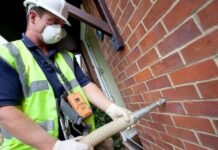Last Updated on August 16, 2022 by
Around 70 percent of homes have some form of mold. This can be a huge nightmare for most homeowners. Mold can cause health problems and structural problems in your home.
Mold is always around and has been for millions of years. It can get in your home through vents, HVAC systems, doors, windows, and vents. Mold is also in the air and can come inside on pets, shoes, bags, or clothing.
Mold also grows where there is moisture like leaky roofs, pipes, windows, or anywhere there was a flood. It can also grow on just about any surface including tile, drywall, carpet, paper, fabric, cardboard, and ceiling tiles.
Wondering how you can stop mold growth in your home? Keep reading to learn more about cleaning and mold removal to keep your home safe—letting you breathe easy.
Table of Contents
Why Is There Mold in My House?
Mold is a natural part of the environment. Mold breaks down organic matter like dead trees and fallen leaves. However, mold indoors is not good.
Molds reproduce through tiny spores, which are not visible to the normal eye. These spores can float around in the outdoor and indoor air, and the spores start growing into mold when they land on wet surfaces.
There are many types of mold that can be a variety of colors. Mold can look like spots and can smell musty. If you smell or see mold, you should remove it quickly, no matter the type of mold.
Can Mold Cause Health Problems?
Mold is usually not a problem indoors unless it lands on a wet surface and begins to grow. Mold does have the potential to cause health problems. Most molds create allergens that cause allergic reactions. They also create irritants and some toxin substances known as mycotoxins.
If you touch or inhale mold, you can have an allergic reaction. These symptoms include red eyes, runny nose, sneezing, and skin rash. Allergic reactions to mold are actually pretty common, and these reactions may be immediate or delayed.
How Do I Get Rid of Mold?
You can’t get rid of all the mold and mold spores indoors since they can be found floating around the air and in house dust. However, mold spores will not grow if there is no moisture. You can prevent mold by controlling the moisture inside your home.
If you already have mold growth in your home, you need to clean it immediately and fix the water problem. If you don’t fix the water issue, the mold will likely come back.
If you have mold, you need to act quickly. Mold damages the surfaces it grows on, and it will cause more damage the longer it grows.
You can remove mold on hard surfaces with soap, water, and a bleach solution of no more than one cup of laundry bleach to one gallon of water. If you use other household cleaners, make sure they are labeled as a mold killer.
Before deciding to clean the mold up yourself, you have to take into consideration the size of the mold problem. If the moldy area is less than 10 square feet, you can probably handle it yourself.
If you use bleach to clean the mold in your home, never mix it with ammonia because it can produce poisonous gas. You should always open the doors and windows to let in fresh air after using bleach. Wear rubber gloves, goggles, and rubber boots when you clean the affected areas.
However, if there was a lot of water damage or the mold growth covers more than 10 square feet, you may want to hire a contractor to clean up the mess. These professionals can help detect additional mold problems you cannot see with your bare eyes including mold in the ventilation or HVAC system.
Check out http://www.themoldguyinc.com/ for more information on hiring a professional to clean up and kill mold in your home.
How Do I Prevent Mold Growth?
The main goal to prevent mold from growing in your home is to stop the moisture from building up. If you already had mold and cleaned it up, it’s important that you follow these steps to prevent it from coming back. These steps will also help eliminate mold from growing in your home.
Measure Indoor Humidity
Mold will not grow without moisture. Humidity and gaseous water in the air are the leading contributors to mold growth. You can double-check the humidity in your home by purchasing a hygrometer to measure the humidity levels in your home at all times.
The EPA recommends that indoor humidity should be between 30 and 50 percent to stop mold growth. If your home’s humidity is above 60 percent, the chance of dangerous mold growth increases dramatically.
Dehumidifiers are a great way to control moisture in your home, especially in your basement. Be sure to check them regularly and empty out the buckets when they are full.
Monitor Outdoor Drainage
Landscaping knows how to prevent mold, so pay attention to the water path on your property. Water should always drain away from your home. If the water goes toward your foundation or pools near your home, it can lead to serious issues.
This is because moisture will begin to trickle down your home’s foundation and leak in. This is why basements tend to be mold hotspots. This is why you need to make sure water drains away from your property, so contact a local landscaper to help with this outdoor drainage.
Use Household Exhaust Fans
Your home should have exhaust fans in the kitchen and in the bathrooms. These are intended to keep moisture and smoke away.
You should run your kitchen’s exhaust fan when you boil water. When you start boiling water, you are adding new water vapor to your home, and this can stick to the walls in your kitchen and increase your home’s indoor humidity.
You should also do the same when you use your shower or tub. If you don’t run the exhaust fan when you shower or bath, the steam can condense on your walls, ceiling, and vanity. You should also wipe down your shower walls to remove scum and mold after use.
Let the exhaust fan run during and after your shower or bath to make sure all the steam is evaporated.
Improve In-Home Ventilation
Ventilation is another important factor to help stop mold. You need proper in-home ventilation to keep the air circulating. Air can only hold so much water vapor, and if that limit is reached or the temperature changes, the water may condense.
If this happens, you will start to see water beading up on your walls and windows. Keep your windows open to help air circulate through your home. Outdoor air also helps regulate indoor humidity.
During the cooler months, you can keep air moving through your home by using standing fans, ceiling fans, or the fan on your home’s HVAC.
You should also leave your doors open so the air can circulate in your rooms. Make sure you leave space between your furniture and your walls as well.
Make sure all of your appliances that use water are properly vented outside and not into your attic. This includes exhaust fans and your clothes dryer.
Don’t Ignore Spills
Whenever you spill water, make sure you mop it up quickly. this includes the bathroom, kitchen, or any other room. Do not leave wet clothes, towels, or umbrellas on the floor.
Keep wet items off your carpet. Carpets can absorb moisture, and they are harder to keep dry. If you notice a funny smell a few days after your carpet gets wet, you may have mold.
Repair Leaks
You should always keep an eye on your home’s plumbing. Even a small leak can lead to a serious mold problem. Be sure to check all the open pipes in your home once or twice a month.
Look at the pipes under the sinks, in the basement, and behind the toilet. If there is a small leak, you can have a serious problem by the time you discover the leak if you don’t regularly check your plumbing.
Keep Your Rain Gutters Clean
Just like the landscape around your home should divert the water, your gutters should do the same. However, if they are not clean, they can’t do their job. Debris, including leaves, can build up in your gutters over time.
This causes your gutters to spill over whenever there is a downpour. The water will then run directly down your home’s siding and can filtrate into your home. This water building up can also cause mold to grow in the attic and behind the walls—but, you can prevent this by keeping your gutters clean.
Pay Attention to Your Bathrooms
Bathrooms produce a lot of moisture. Use a squeegee in your shower to dry the walls and tubs. You can also use a towel. Don’t let the water sit in your shower or tub when you are done.
Also, make sure you dry out everything. This includes your loofahs, sponges, towels, washcloths, and product bottles. When you are done showering, remove them to let them dry.
Don’t leave wet towels on the floor. You should wash your mats, rugs, and towels regularly.
Prevent Mold Growth
By lowering the amount of moisture in your home, you can prevent mold growth. Always check your plumbing and drainage for leaks and repair immediately. Let the air circulate through your home and run your HVAC system regularly.
There are small steps you can take to be a smart homeowner. Keep looking at our site for more great advice to keep your house clean, safe, and comfortable.



























